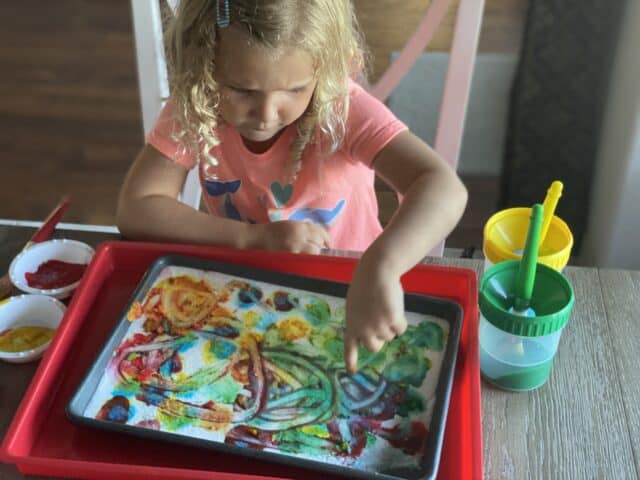Have you tried ice painting? This easy art activity for kids is such a cool sensory experience too!
I came up with this way of ice painting several years ago when we were trying to do a science project and my mind was blown. It is art, science, and sensory play all mixed into one!
Inside this post I share the easy set up process along with two different ways you can paint on the ice! Your kids will love it!
RELATED: Do you need more awesome art activities? We have tons!
How to get started with ice painting
Toddler Approved is a participant in the Amazon Services LLC Associates Program, an affiliate advertising program. As an Amazon Associate, I earn from qualifying purchases. Read more about these links in my Disclosure Policy.
What you need:
- Small baking pan ((1/2 size jelly roll pan) or small container with an edge
- Water
- Baking soda (2 tbsp)
- Washable paint
- Paintbrushes
- (Optional) Craft trays
- (Optional) Paint cups
Prep Ahead:
A day ahead of time you'll want to grab your baking soda, small baking pan (1/2 size jelly roll pan), and some water.
- Fill up your baking pan 1/3 of the way with water.
- Add 1-2 tablespoons of baking soda.
- Mix the water and baking soda together.
- Freeze the baking pan in the freezer overnight.
Now you're ready to paint!
Remove your pan filled with ice from the freezer and you're ready to get started.
Fill up some cups with paint and give your child some paintbrushes and let her start painting on the ice!
This ice art activity is an open-ended process art experience. There is no right way to paint.
What is process art? My friend Rachelle at Tinkerlab (an awesome art teacher!) shares that "Process Art is art that is child-directed, choice-driven, and celebrates the experience of discovery. In process art, the final product is always unique and the focus lies in the creation of the work, not the outcome."
This ice painting process is the coolest!
Encourage kids to explore the surface of the ice with the paintbrushes or even their hands!
We did paintbrush painting AND finger painting when we tried this activity. Both give the kids a different art and tactile experience.
Each child will be different in how they want to explore this material, so just follow their lead.
In addition to being an art activity, this is also a science experience!
Encourage kids to explore the ice and see what makes it melt faster or slower. My daughter decided after awhile of painting that she wanted to try painting with some warm water. It was fun to paint and also watch the ice melt.
My son extended this activity by asking for some vinegar, since he knew that there was baking soda in the paint. He was curious to see if the baking soda ice would react with the vinegar to make a fizzy experiment. We tried it out and he tweaked a few things to make it work a bit. It didn't do exactly what he thought it would do, but it was still a cool problem solving experience for him.
Have you tried painting on ice before like this?
RELATED: There are so many other cool ways to paint! Here are 15+ favorite ways to paint.















Leave a Comment